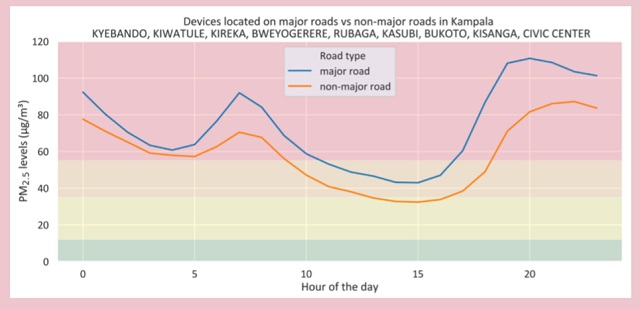
Dr. Bruce Kirenga, the director of the Lung Institute at Makerere University says particulate matter includes small particles one cannot see with their naked eyes but have the ability to penetrate one’s respiratory system through the lungs “Air pollution is very funny because it does not kill you when you are seeing and so, you may not believe its lethal impact.”
He says air quality ranges from good, moderate, unhealthy for sensitive people (asthma, heart disease patients), unhealthy, very unhealthy and hazardous. He says air pollution can decrease one’s lung function and growth especially among young children.
Kampala which is said to be one of the most polluted cities on the continent has multiple sources of outdoor pollution including; dust, industrial fumes, vehicle emissions and waste burning. When taken in total, these are contributing to the city’s failing air quality, the researchers from the AirQo project say.
They say air quality in Kampala ranges between 70 for moderate to over 160, which is beyond ‘unhealthy’ for breathing. Between 0-50, air quality is considered good; at 50-100, it is considered moderate; 100-150 is hazardous especially to the sensitive population while above 150 is hazardous to the general population.
The researchers say air quality around the city also varies depending on where one lives. Residents who live in the south and southwest of the city, for instance, are generally less exposed to unhealthy air because the wind tends to come from this direction over Lake Victoria while areas with the highest concentration of tiny noxious particles known as PM 2.5 are located around major road junctions of the city. The Northern Bypass and Jinja Road are mentioned.
Kireka probably has the worst combination when it comes to poor air quality. It is on the main route to Jinja in eastern Uganda and registers a lot of traffic coming all the way from Kenya. But the area also has many industries crammed there making the residents’ situation worse.
Kireka also hosts thousands of Kampala’s urban poor residents who predominantly use wood fuel and charcoal as their source of energy. Kireka’s air is also not helped by the fact that it is shielded by a hill.
“The wind from Lake Victoria that would otherwise blow away the polluted air is blocked by the hill making the particles hang around,” explains Prof. Bainomugisha.
A similar study carried out by scientists at the Department of Medicine in Makerere University College of Health Sciences in collaboration with several collaborative universities abroad in 2014 noted that Kampala city suburbs where most of the poor residents live such as Nateete, Rubaga, Mengo, Nansana and Najjanankumbi as well as some sections of Entebbe Road, have the worst air while the more affluent suburbs of Naguru, Kololo, Kiwatule, and Mbuya have better air quality.
When taken across the year, air quality in Kampala is much better during the wet seasons especially in October and May and worse during the dry season – in January and July. When rainfall is high in a given month then the amount of PM2.5/m3 in the air is lower while when rainfall is low it is much higher.
While launching the project, Prof. Bainomugisha noted that lack of air quality data to quantify the magnitude and scale of air pollution levels is not only a big challenge in Uganda but also across the African continent owing to the cost of air monitoring equipment.
Up until 2016, Uganda had only one air quality monitor owned by the US Embassy in Kampala, measuring PM2.5 particulates as an indication of the air quality around the embassy’s surroundings.
But thanks to a US$ 1.3 million grant from American technology giant Google, AirQo is now building low cost sensors that cost as low as US$ 150. These are designed to withstand harsh conditions like heat, intermittent connectivity and power, humidity, rain, dust and even insects, which even the U.S and European built devices, cannot cope with.
The air monitoring devices have been installed across the city at static locations in schools, neighbourhoods, streets and buildings. They have also been installed on mobile objects such as boda-bodas. In just a few months, AirQo has been able to transform Uganda into one of the most monitored countries on the continent.
The team at AirQo has gone ahead to develop an app for people to access real time air quality information from wherever they are. Daniel Ogenrwot, a software engineer told The Independent that the new air quality testing app helps one understand the air quality at a particular place at one point in time.
“It can be accessed on Google playstore or Apple store for IOS devices,” Ogenrwot told The Independent, “When you access this app, you are able to track your current location and if our device is near that location, you will be able to know the air quality at that point.”
“The app shows air quality information of the place and it gives you a forecast of up to 48 hours. If you are planning an event tomorrow and you want to know how good the air quality will be, the app will be able to help.”
 The Independent Uganda: You get the Truth we Pay the Price
The Independent Uganda: You get the Truth we Pay the Price



First you say, ““The worst time to jog in Kampala is in the morning hours while afternoon hours are the best,” Prof. Engineer Bainomugisha, the Principal Investigator at AirQo told The Independent recently.”
Then immediately afterwards, ““By 3pm, most areas have moderate air quality or unhealthy air quality for sensitive groups such as those who are asthmatic,” said Prof. Bainomugisha on Feb.26, “At around 8PM, Kampala’s air registers red (unhealthy) and orange (unhealthy for sensitive groups) in some instances but it can turn purple (very unhealthy).””
What is wrong with you people?